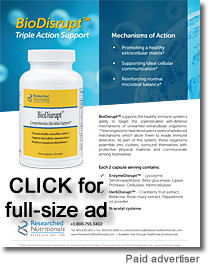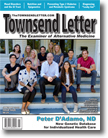|
Page 1, 2
I'm sprawled out on our Ikea couch watching Netflix and chilling after flying home from Vancouver, British Columbia, and the BC naturopathic association's conference. My wife starts shouting from the laundry room; "It's a miracle. It's a miracle!" Her exclamations outcompete Disenchantment, and I hit pause. Entertainment must wait.
Years ago, I shared a hotel room with Torrey Smith, ND, from Alaska at an AANP conference in Oakland. He brought an empty suitcase along just to have enough space to bring home the vendor samples he collected. Free stuff is always hard to resist, and the eminent Dr. Smith managed to easily fill his suitcase.
I try to limit how many samples I carry home as they often just sit around for years; yet, I can never resist bringing home a few pens. Those pens vendors give away are often nicer than the ones we purchase from Office Depot. We have yet to switch over to EMR. I still take patient notes using a clipboard, pad of paper, and pen. So, when free pens are offered, I can't resist.
 Townsend Letter provides a platform for those examining and reporting on functional and integrative medicine. Please support these independent voices. Townsend Letter provides a platform for those examining and reporting on functional and integrative medicine. Please support these independent voices. |
Before turning on the TV that evening, I had tossed the three white dress shirts that I wore in Vancouver into our washing machine along with the white blouses that my dear wife wears when volunteering to usher at the theatre downtown. She grabbed a handful of white things from the laundry hamper and turned on the machine. Neither of us checked my shirt pockets. So, neither of us found the pen I'd brought home. The pen that leaked out in the wash.
 "It's only shirts" she is saying as she began her inventory of the damage. "It could be worse: our house has not been blown away by a hurricane." Moments later she abandons this calm rationalizing. "It's a miracle, Baruch H'Shem," (as in 'Blessed is the Name', an expression usually employed by my very religious sister-in-law but not by my usually agnostic wife). "It's only shirts" she is saying as she began her inventory of the damage. "It could be worse: our house has not been blown away by a hurricane." Moments later she abandons this calm rationalizing. "It's a miracle, Baruch H'Shem," (as in 'Blessed is the Name', an expression usually employed by my very religious sister-in-law but not by my usually agnostic wife).
The ink has leaked out of the pen for certain, but it was entirely contained on a single pair of her underwear and one of my ‘'wife beater' undershirts. Our white dress shirts and blouses were spared. "This must be a sign" she starts saying. But of what I wonder?
If all of our shirts had been ruined, I would have taken it as a sign to quit my day job; no more going to the office. I would wear flannel shirts and live in the woods where ink splotches don't matter. Miracles, if they are anything, are exclamation points in life that suggest one pay attention. But to what?
Was there something at the conference, some imparted wisdom or an epiphany that I missed that I'm supposed to heed? I actually open and relook at the conference PowerPoints. Glen Cassie, the executive director of the BC naturopathic association, put on a solid conference, no question about that. It was tightly and smoothly run, without any noticeable hiccups and, thank goodness, he supplied thumb drives of all the lectures. On top of that, we lucked out with sun all weekend, something that I'm told is rare.
I like Canadian conferences. I've written that before. With the current exchange rate as it is, as soon as we Americans cross the border, it is as if everything is on sale. How can you not love that? Between the accents, the European styles, my impression is that our Canadian colleagues are smarter, healthier, and better looking than we Americans are. They always seem so earnest about everything. Plus, that was the week pot was going to be legalized nationwide. There was a buzz of excitement in the air.
This conference's topics were kind of cerebral. Let me explain that. Most of the lectures had something to do with the brain and how it functions. Doni Wilson lectured on Alzheimer's disease, Bill Code, MD, on neurovascular connections to the brain, Pamela Hutchison on dissociative disorders, David Musnick, MD, on healing brain injuries, Laurie Mischley on Parkinson's, Nalini Chilkov, LAc, on treating cancer chemo-brain, and so on. See what I mean? The lecture topics were focused on cerebral function.
This made for an interesting overall effect as many of the speakers covered similar terrain, each adding a slightly different perspective to the same territory. I found that approach novel. The same basic ideas related to brain health showed up again and again, and perhaps even started to sink in. Though there is a limit on how much you want to hear about stress and glycemic control before it gets old.
As many nice things as I have to say about Canadians, I confess that I wonder if they aren't too nice, or sometimes naïve to the point of being gullible. They may bring less skepticism to the table, and perhaps are more willing to take a speaker's word on things than I am. In my (oft repeated) view, there is a standard for referencing and citations that should be expected in all professional communications these days that was lacking in some of the presentations. If a speaker states a novel idea or makes an unusual claim, I expect a citation backing it up. I don't think speakers are making things up or are delusional. I just need a citation if I share their idea with another doctor, especially a medical practitioner who may not share our casual approach to science.
For example, one speaker stated that patients recovering from traumatic brain injury (TBI) must absolutely be on diets free of gluten and dairy. There is little debate anymore that celiac disease may have neurological complications.1 This is accepted fact. Yet to suggest that gluten avoidance may benefit a non-celiac TBI patients in my opinion deserves a reference. I've failed at finding one.
When it comes to milk and TBI, there is an August 2018 paper by YY Gao et al that suggests the opposite of this idea to avoid milk to heal brain trauma. Gao suggests that a factor in milk, "… milk fat globule-EGF factor-8 (MFG-E8) provides neuroprotection through modulation of inflammation, oxidative stress, and especially apoptosis…" after traumatic brain injury.2 This is exactly why I want speakers to use citations. I want to know how they arrived at their ideas, and I want to be able to believe what they tell me.
I was half joking that much of the conference was cerebral because it was about brain dysfunction and related morbidities. These lectures were also cerebral in the regular sense; they were very brainy, in a functional medicine kind of way; they were the kind of lectures MDs give when they think they are practicing naturopathy. The lectures were heavy on chemical pathways, Venn diagrams and charts with arrows and pathways that all fit together and left me with lists of exotic lab tests to run and supplements to sell.
There was one notable exception to this cerebral line up. Alan Logan gave a keynote lecture that inspired me to think far outside the box of my normal clinical practice model. He reviewed highlights from the scientific literature supporting the benefits exposure to nature has on health. As heavily cited and intellectual as his lecture was, he touched my heart. To this he added a review of the evidence of how nature exposure affects the body's biome and even suggested that this may in part be the mechanism of action of how nature exposure improves health. This combination of viewing the health-imparting effects of nature on both a macro and microscopic level was fascinating. He suggested that we should be actively accessing the degree of nature exposure our patients get and then actively promoting increases in their exposure. Dr. Logan presented a solid argument that this growing field of medicine, the Medicine in Nature, is a niche that the naturopathic profession should claim ownership of. While I try to keep up with this research, I have not actively incorporated these ideas into my practice as rigorously as I might. I now intend to. I might add that our naturopathic schools do not appear to offer adequate classes for students to even learn the techniques to employ nature in clinical practice.
Logan started his lecture with a quote from a 1914 British Medical Journal article and then reminded us all of how urbanized our world has become in the intervening years since JA Thompson wrote these words:
It is, I submit, a condition of sanity to know the country and the seasons, the hills and the sunrise, the birds and the flowers; to know – not merely to read about – the changeful music of the sea. There would be less psychopathology of everyday life if we kept up our acquaintance with the bonnie briar and the cry of the moorland.3
Logan's lecture resonated deeply and reminded me why I felt called to become a naturopath in the first place. I've never taken well to selling supplements. I became a naturopath because it seemed like a way to celebrate our natural world and preserve it. Personally, I have always taken pleasure and solace in being outside but have not prescribed the same to patients.
Logan did a great job of reviewing the science that supports our belief that exposure to nature has healing effects. In that respect he was perhaps the most cerebral of the presenters. We're all vaguely familiar with these ideas as they are often covered in the popular media, and some of our colleagues have made efforts to bring these studies to our attention over the years. (I'm thinking of Kurt Beil's writing in the Natural Medicine Journal.) Logan questioned why nature and what the researchers call nature connectedness are not a fundamental part of naturopathic education and why all of us aren't assessing the level of nature exposure in each of our patients and working hard to increase it.
The explanation I've heard from some is that there is no money in nature. I queried a conference planner recently about organizing a nature-focused conference. The response, "I don't think we could make any money, or really even break even because there isn't really a sponsor opportunity…." Our current conference financial model is dependent on vendor sponsors who have something to sell. We may need a new model of funding our conferences so that we can break even. At the same time our professional associations and individual doctors who set up conferences depend on and are highly desirous of making profits. Nature has nothing to sell, will not buy booths in the vendor hall, and will not sponsor meals.
If the other conference lectures were cerebral, Logan's lecture was the opposite: his ideas resonated in my heart of hearts and echoed loud in my core. I do not often say that about a conference speaker.
If I'm going to consider our ink episode a minor miracle, (it's not in the Red Sea-parting league obviously), the message was delivered in Dr. Logan's lecture. It's time to focus naturopathy back on nature.
Page 1, 2
|
![]()
![]()
![]()
![]()






